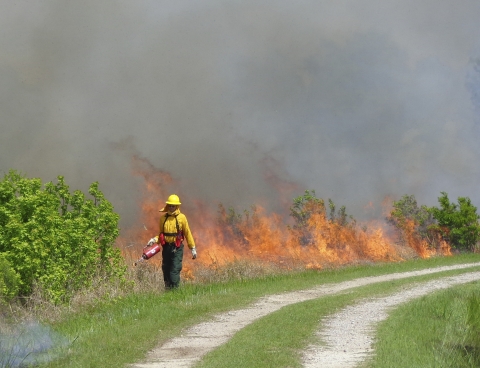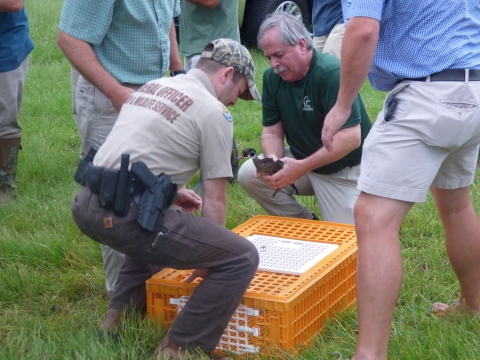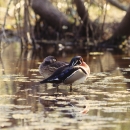What We Do
Wildlife conservation is at the heart of the National Wildlife Refuge System. It drives everything on U.S. Fish and Wildlife Service lands and waters managed within the Refuge System, from the purposes for which a national wildlife refuge national wildlife refuge
A national wildlife refuge is typically a contiguous area of land and water managed by the U.S. Fish and Wildlife Service for the conservation and, where appropriate, restoration of fish, wildlife and plant resources and their habitats for the benefit of present and future generations of Americans.
Learn more about national wildlife refuge is established to the recreational activities offered to the resource management tools used. Using conservation best practices, the Refuge System manages Service lands and waters to help ensure the survival of native wildlife species.
Santee NWR was established to manage, conserve, and protect habitat for migratory birds. Santee contains a variety of habitats that also benefit threatened and endangered species and other types of wildlife. The refuge protects natural resources and provides opportunities for outdoor recreation activities that are compatible with the refuge purpose and connect people with nature.
Habitat management is required to support the variety of wildlife species that use the refuge and multiple management efforts and techniques are employed. Management efforts include the control of water levels in marshes, impoundments, and woodlands. In addition, prescribed burning, mowing, farming supplemental wildlife foods, using nest boxes, and controlling invasive species invasive species
An invasive species is any plant or animal that has spread or been introduced into a new area where they are, or could, cause harm to the environment, economy, or human, animal, or plant health. Their unwelcome presence can destroy ecosystems and cost millions of dollars.
Learn more about invasive species are tools used at Santee NWR.
Santee NWR offers a variety of activities and programs for visitors. Hunting and fishing are popular and permitted on the refuge. Deer and small game hunts are scheduled annually and, fishing is allowed in designated areas and at certain times of the year. Hunting and fishing activities are in accordance with state regulations and specific refuge regulations. Wildlife observation, photography, environmental education, and interpretation are also encouraged activities on the refuge. The refuge has a wildlife auto tour and several trails for hiking, biking, and boating.
Management and Conservation
Refuges deploy a host of scientifically sound management tools to address biological challenges. These tools span active water management to wilderness character monitoring, all aimed at ensuring a balanced conservation approach to benefit both wildlife and people. At this field station our conservation tool box includes:
Planning
The Santee NWR Comprehensive Conservation Plan describes how the refuge will contribute to the mission of the Refuge System. Direction and implementation include habitat management, fish and wildlife conservation, wildlife-dependent recreation, and compatible uses of the refuge.
Fish and Wildlife Population Management
Management and monitoring of Wood duck populations, migratory waterfowl, wading birds, grassland birds and neotropical migrants occur at Santee NWR. The refuge also provides habitat for species listed as threatened, endangered and of high priority concern like the Wood stork, Painted bunting, and Shortnose sturgeon . A variety of management tools are used to increase habitat diversity and wildlife diversity.
Habitat Management and Restoration
Water Management in marshes, impoundments and other wetlands involves adjusting water levels for the maximum benefit of wildlife. In impoundments and marshes, different levels are used to enhance native vegetation growth, while controlling unwanted, invasive species invasive species
An invasive species is any plant or animal that has spread or been introduced into a new area where they are, or could, cause harm to the environment, economy, or human, animal, or plant health. Their unwelcome presence can destroy ecosystems and cost millions of dollars.
Learn more about invasive species . Periodically- flooded woodlands containing nut-producing hardwoods are food-rich and beneficial to waterfowl. The refuge works with the SC Department of Natural Resources (SCDNR), Santee Cooper and Ducks Unlimited to improve aquatic health, protect native wetland plant communities and reduce non-native, invasive aquatic weeds.
Refuge forests are maintained with techniques ranging from prescribed burning to selective thinning. Fields, grasslands and shrublands are maintained through prescribed burning, mowing, and using mechanical equipment to provide suitable wildlife habitat. Prescribed fire is used to remove undesirable vegetation and produce seed crops, grasses, and other food sources for wildlife. Mechanical disking in fields called fire breaks are also employed to control overgrowth and enhance wildlife movement and habitat diversity.
The refuge also manages invasive species to improve habitat management effort. Terrestrial and aquatic species such as Chinese tallow, Japanese climbing fern, Giant cutgrass, Alligator weed, Feral hog and others are an issue on the refuge. Mechanical and chemical methods are used to help control invasive plants, while monitoring, trapping and annual hunts are used to help control the feral hog population.
Agriculture
Refuge croplands are farmed by refuge staff and cooperative farmers. Supplemental wildlife crops include wheat, millet, and rice. These crops provide an excellent source of high-energy foods for wintering waterfowl as well as other wildlife species.
Visitor Services
Hunting and Fishing: The Refuge works with the South Carolina Department of Natural Resources, the Orangeburg National Fish Hatchery, and Santee Cooper to support recreational hunting and fishing opportunities that help to maintain healthy wildlife populations. Deer and small game hunts are scheduled annually. Fishing for bass, catfish and bream is popular on the refuge.
Education, Outreach and Recreation: Environmental education, interpretive programs and outreach events are periodically scheduled. Volunteer assistance and partnerships with historical associations, resource agencies, schools, colleges/universities, and civic groups provide opportunities for educational tours on the refuge. Santee NWR is also often a sought after location for wildlife observation, photography, hiking, biking, and boating.
Cultural Resources: The refuge is home to the Santee Indian Mound which dates back over 1200 years. The mound was used as for ceremonial rites and as a burial site. The mound was also used as a British outpost during the Revolutionary War. Brig. General Francis Marion and Lt. Colonel Henry “Light Horse Harry” Lee ultimately took over Fort Watson in battle. In 1969, the Santee Indian Mound was added to the National Register of Historic Places.
Law Enforcement
Federal Wildlife Officers patrol refuge properties to protection resources. Officers work closely with local, state, and federal agencies to protect wildlife, habitat and ensure public safety on the refuge. Officers also enforce hunting, fishing and safety regulations, the Migratory Bird Treaty Act and other wildlife laws.
Our Projects and Research
Bat Surveys - Numerous bat surveys have been conducted on the refuge since 2006. These surveys include acoustical analysis using an ANABat System, designed to identify bats by detecting and analyzing their echolocation calls. This system can be set-up in a stationary location or by driving a designated route. Mist nets are used to capture the bats and data is collected and recorded before releasing them.
Tree Swallow Research - The breeding biology and movement ecology of Tree Swallows at Santee NWR has been studied in collaboration with Davidson College since 2015. Additional collaborators from Indiana University are also conducting research on behavioral and physiological changes in breeding populations of Tree Swallows along the Eastern Coast related to environmental stressors.
Law Enforcement
Federal Wildlife Officers patrol refuge properties to protect our public resources. Officers work closely with local, state, and federal agencies to protect wildlife, habitat and ensure public safety on the refuge. Officers also enforce hunting, fishing and safety regulations, the Migratory Bird Treaty Act and other wildlife laws.
Laws and Regulations
At Santee NWR, we strive to protect our natural and cultural resources and work to ensure that visitors have a safe and enjoyable visit. Please follow all rules and regulations outlined in the refuge brochure when visiting the refuge. You can pick up the refuge brochure at our visitor center. Become familiar with and follow all applicable state fishing regulations while fishing on the refuge and, follow all federal and state laws and applications when hunting at Santee NWR.








